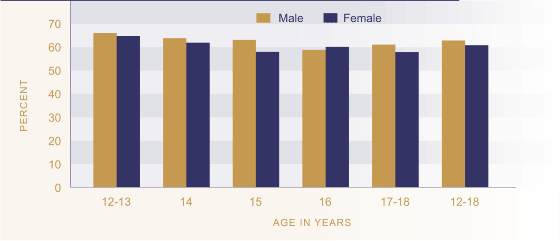Relevance
Healthy relationships are built through both the quantity and quality of time spent together. Young people having enough time with their parents is a proxy indicator of the extent to which those in need of care and nurturing receive appropriate support.
Current Level
In 2001, 63 percent of male students and 61 percent of female students reported that most weeks they were able to spend enough time with at least one parent.
Figure SC5.1 Students reporting they
spent enough time with their parent(s), 2001

Source: Adolescent Health
Research Group, (2003a)
Age And Sex Differences
There were no significant differences by sex in the proportion of students reporting that they spent enough time with at least one parent. Girls at 15 years of age reported less often than younger boys and girls (12-13 years) that most weeks they were able to spend enough time with Mum or Dad.
Ethnic Differences
Fifty-five percent of Māori students and 65 percent of European students reported that most weeks they were able to spend enough time with Mum and/or Dad. The difference was statistically significant after adjusting for age, sex and socio-economic differences between the two ethnic groups. Pacific students (60 percent), Asian students (65 percent) and students of other ethnic groups (60 percent) showed no statistically significant difference from New Zealand European students after adjusting for age, sex and socio-economic differences.
